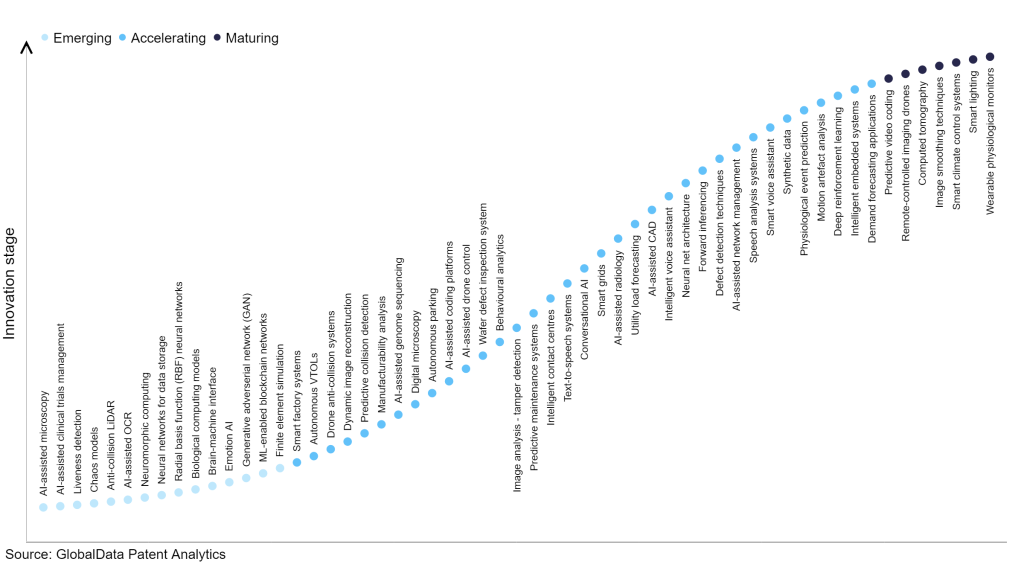The technology industry continues to be a hotbed of innovation, with activity driven by the increasing prevalence of chronic diseases, the need for early detection and prevention of health issues, and the availability of large datasets for training artificial intelligence (AI) models, as well as growing importance of technologies such as machine learning algorithms, deep learning neural networks, data mining techniques, and wearable devices for data collection. By leveraging AI capabilities, physiological event prediction aims to enhance healthcare outcomes, enable timely interventions, and improve overall patient well-being. In the last three years alone, there have been over 3.6 million patents filed and granted in the technology industry, according to GlobalData’s report on Innovation in Artificial Intelligence: Physiological event prediction. Buy the report here.

Access deeper industry intelligence
Experience unmatched clarity with a single platform that combines unique data, AI, and human expertise.
However, not all innovations are equal and nor do they follow a constant upward trend. Instead, their evolution takes the form of an S-shaped curve that reflects their typical lifecycle from early emergence to accelerating adoption, before finally stabilising and reaching maturity.
Identifying where a particular innovation is on this journey, especially those that are in the emerging and accelerating stages, is essential for understanding their current level of adoption and the likely future trajectory and impact they will have.
300+ innovations will shape the technology industry
According to GlobalData’s Technology Foresights, which plots the S-curve for the technology industry using innovation intensity models built on over 2.5 million patents, there are 300+ innovation areas that will shape the future of the industry.
Within the emerging innovation stage, finite element simulation, ML-enabled blockchain networks, and generative adversarial networks (GAN), are disruptive technologies that are in the early stages of application and should be tracked closely. Demand forecasting applications, intelligent embedded systems, and deep reinforcement learning are some of the accelerating innovation areas, where adoption has been steadily increasing. Among maturing innovation areas are, wearable physiological monitors, smart lighting, and smart climate control systems, which are now well established in the industry.
Innovation S-curve for artificial intelligence in the technology industry

Physiological event prediction is a key innovation area in artificial intelligence
Physiological event prediction involves utilising data gathered from physiological sensors to anticipate and forecast various physiological events or responses. This encompasses predicting occurrences such as the onset of a heart attack or seizure, forecasting drug-induced side effects in patients, or anticipating an athlete's reaction to a specific exercise regimen. By leveraging the collected data and employing predictive algorithms, physiological event prediction aims to enhance proactive healthcare management, facilitate timely interventions, and optimise individualised treatment plans.
GlobalData’s analysis also uncovers the companies at the forefront of each innovation area and assesses the potential reach and impact of their patenting activity across different applications and geographies. According to GlobalData, there are 260+ companies, spanning technology vendors, established technology companies, and up-and-coming start-ups engaged in the development and application of physiological event prediction.
Key players in physiological event prediction – a disruptive innovation in the technology industry
‘Application diversity’ measures the number of different applications identified for each relevant patent and broadly splits companies into either ‘niche’ or ‘diversified’ innovators.
‘Geographic reach’ refers to the number of different countries each relevant patent is registered in and reflects the breadth of geographic application intended, ranging from ‘global’ to ‘local’.
Philips is a leading patent filer in physiological event prediction. One of the company’s patents focuses on real-time monitoring of a patient's physiological signs, specifically in relation to drug administration. Patient data and drug administration data are collected along with information about the administered drug,its side effects, interactions, and contraindications. Using this data, a processing unit generates time-resolved monitoring information that dynamically highlights the most critical physiological signs to monitor. The monitoring information is then presented through an output interface..
Other prominent patent filers in the space include Medtronic and Heartflow.
By geographic reach, Vizzario leads the pack, followed by Carepredict and Origin Wireless. In terms of application diversity, Applied Materials holds the top position, followed by Teva Pharmaceutical Industries and Enlitic.
AI innovation in physiological event prediction involves the use of advanced algorithms and machine learning techniques to analyse physiological data and predict various events or conditions related to human health.
To further understand how artificial intelligence is disrupting the technology industry, access GlobalData’s latest thematic research report on Artificial Intelligence (AI) – Thematic Intelligence.
Data Insights
From

The gold standard of business intelligence.
Blending expert knowledge with cutting-edge technology, GlobalData’s unrivalled proprietary data will enable you to decode what’s happening in your market. You can make better informed decisions and gain a future-proof advantage over your competitors.







